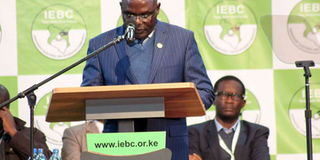Why the IEBC server is the new Nithi in rigging claims

Independent Electoral and Boundaries Commission chairman Wafula Chebukati addresses a press conference at Bomas of Kenya, the national tallying centre, on August 11, 2017. Nasa said the IEBC's systems were compromised during the elections. PHOTO | DENNIS ONSONGO | NATION MEDIA GROUP
What you need to know:
- The 2007 election is widely believed to have been rigged in favour of Mwai Kibaki.
- In the last two elections, supporters of top presidential candidates, have always looked forward to the Nithi moment.
Nithi has come to occupy a dubious place in Kenya’s political legend since the 2007 General Election.
A controversial vote count from a densely populated constituency of the same name at one time arrived at the national tallying centre at KICC, overturning a comfortable lead by Raila Odinga over then President Mwai Kibaki overnight.
That election is widely believed to have been rigged in favour of the incumbent.
TECHNOLOGY
In the last two elections, supporters of top presidential candidates, watching the transmission of results from constituencies across the country on national television, have always looked forward to the Nithi moment – when a huge vote count suddenly lands on the screen to wipe out the rival’s lead or extend the lead over him.
But the increased role of technology in Kenya’s elections and the controversies surrounding it suggest that the vote rigging battleground has shifted.
POLL PETITION
The two Supreme Court petitions challenging the election of President Uhuru Kenyatta in 2013 and 2017 have cited manipulation of results transmission to the IEBC’s national tallying centre at Bomas of Kenya in Nairobi.
In 2013 Raila Odinga, who has filed both petitions, alleged that the IEBC had its server hosted by the same service provider as TNA, Mr Kenyatta’s party for that election.
The double dealing by the service provider, Mr Odinga argued, exposed the electoral commission’s IT system to breaches, including allowing TNA access to the server.
CHRIS MSANDO
The decision by the Willy Mutunga bench to block some of the petitioner’s evidence on technicalities meant that the allegations never got to be tested.
But the suspicions over the possible role of technology in vote rigging persisted, forming much of the background grievances around the 2017 polls, from procurement of service providers to the murder of IEBC’s ICT manager Chris Msando a few days to the August 8 ballot.
The latest Supreme Court petition has all but confirmed many Kenyans’ worst fear having turned up quite a bit of evidence pointing to manipulation of the results transmission.
IEBC
Although the judges have yet to release their full judgment, a leaked memo by IEBC chairman Wafula Chebukati late last week to the chief executive officer, Ezra Chiloba, left little to the imagination.
The terse memo required Mr Chiloba to, among other things, take action against two officials behind the creation of a username and a password in the chairman’s name and which was used to log into the commission’s system 9,934 times.
ASSESS
Mr Chebukati also took issue with the use of a porous file server to transmit forms 34B, which contain constituency result tallies.
There will be no limit on speculation about what else might have happened to those servers after the Chebukati memo, coming as it did following the reluctance by the IEBC to comply with a Supreme Court order requiring their scrutiny.
What is clear is that the IEBC server has effectively replaced Nithi in public conversations about vote rigging.
[email protected] @otienootieno





